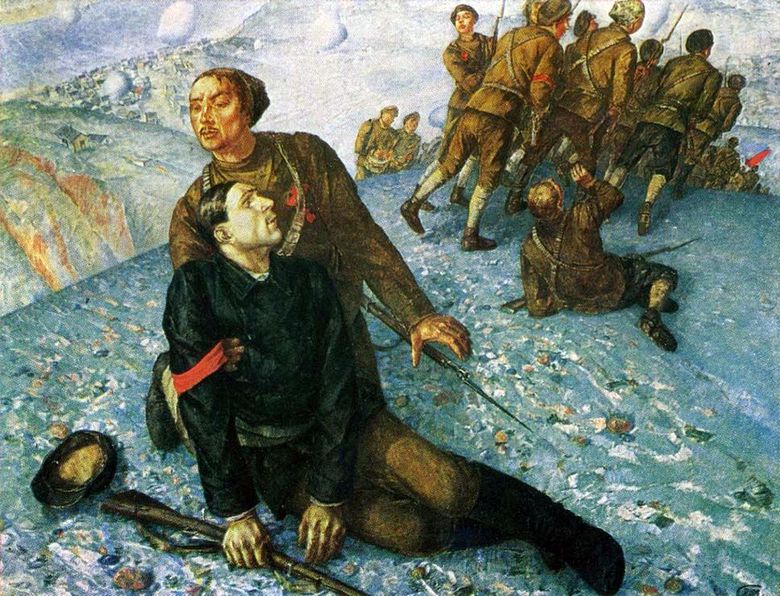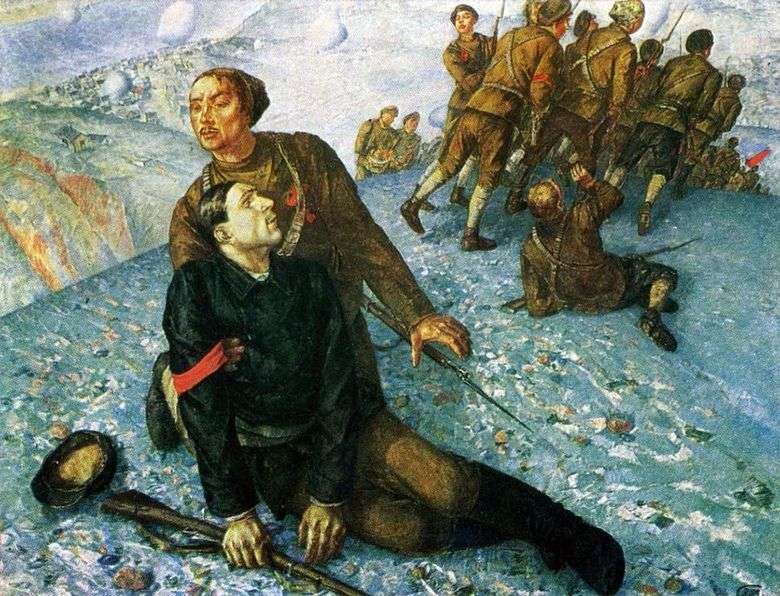
The painting “The Death of the Commissioner” is central to the Soviet period of Petrov-Vodkin. Its creation was preceded by such a significant work of the artist, as “After the battle.” One of the main topics for Petrov-Vodkin, the theme of life, sacrifice and death was solved here for the first time in the images of the heroes of the revolution.
The most profound embodiment of this topic is given in the work “Death of the Commissioner”. The plot is based on one of the episodes of fierce civil war. The mortally wounded commissar falls, his body becomes heavier than the Red Armyman, the detachment of soldiers continues to move forward. However, in accordance with the concept developed by the artist, the scene depicted outgrows the framework of the fact, rising to a philosophical, symbolic sound. In this work, the artistic system of the author, his original understanding of the pictorial space and color scheme, find their full expression.
Focusing on the main group, given a close-up, the master opens in the picture considerable spatial depth with distant settlements, smooth silhouettes of hills, with a blue ribbon of a river. As if through the eyes of a dying commissioner, this world is seen, huge as a planet, and at the same time, close and tangible, acutely dynamic and frozen. Petrov-Vodkin abandons the traditional linear perspective. Compositional point of view, the artist moves in a strict sequence as if on the surface of the sphere, which gives him the greatest completeness of coverage.
This method of spherical perspective plays the role of an artistic metaphor expressing the philosophical position of the author in a poetic form. The event depicted acquires a cosmic human sound. Here is the key to understanding the idea of the painting – the moment the commissioner’s death reveals the meaning of his life, the meaning of his heroic sacrifice, which affirms the revolution. With all the diversity of the compositional construction, the picture is perceived as a plastic whole. This is largely due to the precisely found relationship of silhouette outlines of the central group, detachment and landscape details, the unity of rhythmic organization. A significant role in the figurative decision is played by the coloring of the picture. The whole painting is designed in a harmonious combination of bluish-green and ocher tones.
The color of the picture emphasizes the depth of space, emphasizes the main plans and groups, helps to feel the lightness and transparency of the bluish haze, the materiality, the weight of objects and figures. Tense, dramatic chord sounds black in combination with red in the figure of the Commissioner. The balance of the main color planes determines the integrity and decorativeness of the canvas. By the solemn beauty of the color scheme, the artist asserts the moral beauty of the heroes, their exploits. This work summed up many of the pictorial and philosophical quest of Petrov-Vodkin. In addition, it became one of the landmark works of Soviet art.
 Red Madonna by Kuzma Petrov-Vodkin
Red Madonna by Kuzma Petrov-Vodkin Bathing a red horse by Kuzma Petrov-Vodkin
Bathing a red horse by Kuzma Petrov-Vodkin La mort du commissaire – Kuzma Sergeevich Petrov-Vodkin
La mort du commissaire – Kuzma Sergeevich Petrov-Vodkin La muerte del comisario – Kuzma Sergeevich Petrov-Vodkin
La muerte del comisario – Kuzma Sergeevich Petrov-Vodkin Girls on the Volga by Kuzma Petrov-Vodkin
Girls on the Volga by Kuzma Petrov-Vodkin 1919 Anxiety by Kuzma Sergeevich Petrov-Vodkin
1919 Anxiety by Kuzma Sergeevich Petrov-Vodkin Spring by Kuzma Petrov-Vodkin
Spring by Kuzma Petrov-Vodkin Herring by Kuzma Petrov-Vodkin
Herring by Kuzma Petrov-Vodkin